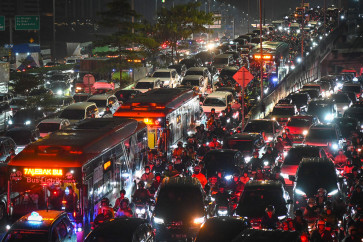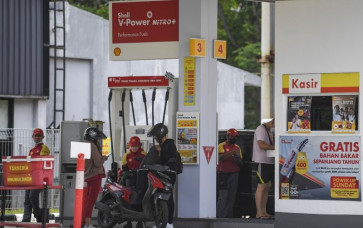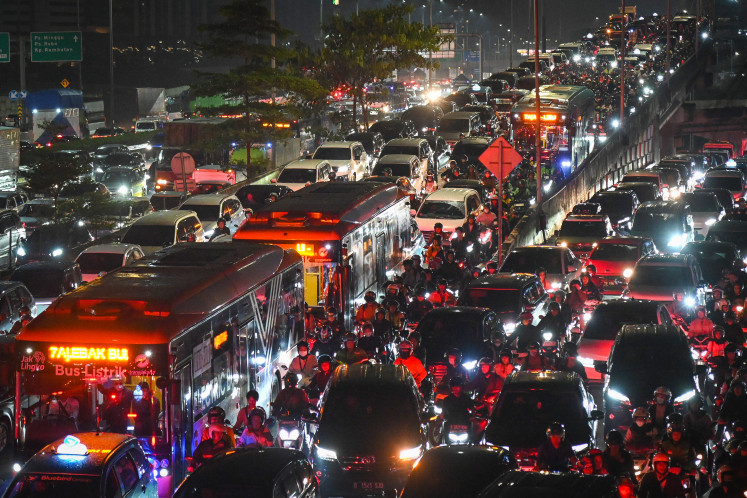Popular Reads
Top Results
Can't find what you're looking for?
View all search resultsPopular Reads
Top Results
Can't find what you're looking for?
View all search resultsIcon of Jakarta, orange ‘bajaj’ drifts into extinction
Expired: Unused bajaj (three-wheeled motorized vehicle) are abandoned in Cideng, Central Jakarta
Change text size
Gift Premium Articles
to Anyone
Expired: Unused bajaj (three-wheeled motorized vehicle) are abandoned in Cideng, Central Jakarta.(JP/Raissa Raniah)
The iconic orange bajaj (three-wheeled motorized vehicle) used to be the king of Jakarta’s streets, with the clattering sound of its two-stroke engine and unruly behavior of its drivers that inspired locals to joke, “when bajaj drivers maneuver, only the driver and God knows the direction”.
The orange bajaj, which along with Jakarta’s landmark National Monument (Monas) and ondel-ondel (giant Betawi effigies) have been adopted into many forms of souvenir, is now nowhere to be seen as it has been replaced by the greener liquefied natural gas-powered blue bajaj.
Indra Permana Kusumah, a craftsman from Tasikmalaya in West Java, however, still cannot remove the orange bajaj from his memory.
“I remember it as part of my childhood. I would ride bajaj to go around Monas whenever I visited Jakarta for holidays back in the 80s and 90s,” he said.
Now an adult, Indra keeps hold of his memory of orange bajaj in the form of bajaj- and bemo-shaped pen holders made of medium-density fireboard, which won him a prize at the Jakarta Souvenir Design Awards held by the Jakarta chapter of the National Handicraft Council last month.
“The long existence of orange bajaj in Jakarta is what makes it an icon of the city,” he said.
Bajaj, which were manufactured by Indian firm Bajaj Auto, hence the name, was first brought to the capital during the tenure of then-governor Ali Sadikin in the 1970s.
In 2013, however, the Jakarta administration gradually phased out the orange bajaj and replaced it with the blue bajaj.
As Jakarta is now moving toward modern forms of transportation such as the MRT, which is expected to start operation next year, and vehicles that are powered by greener energy like electricity and compressed natural gas, the orange bajaj is no longer considered relevant as a fixture of the capital.
As of this year, almost all 14,000 orange bajaj have been phased out, making them harder to find.
Moreover, with the mushrooming of app-based transportation, some residents think Jakarta is better off without the bajaj.
“It’s impossible to find the orange bajaj now. Besides, who needs them when we have ride-hailing applications on our phone,” Danya Sarastiwi, 22, a South Jakarta resident, said.
Another resident, Thelya Gita, believed that even though the orange bajaj had slowly drifted into extinction and replaced by modern transportation, it will still hold nostalgic value.
“As time goes by, I believe that people will not question the vanishing of the orange bajaj, because other modes of transportation will cater to their needs. However, it is still an important part of the history of Jakarta’s [transportation] as it had been around for a very long time.”
Some of the bodies of the orange bajaj, however, can still be found in one corner of Jakarta, namely Gang Makmur, Cideng, Central Jakarta.
In the alleyway, some orange bajaj lie broken and rusty on the roadside. Once in a while, its successor, the blue bajaj, passes through the alleyway.
A Gang Makmur resident, Iwan, who is also the head of neighborhood unit 04, recalled that Gang Makmur was a popular place for bajaj drivers when a bajaj repair shop opened in the late 80s, followed by several others that are still operating today but cater to the blue bajaj.
A bajaj owner, Yanto, told The Jakarta Post that the number of orange bajaj stored in Gang Makmur had decreased dramatically from a few years back. “A lot of them were picked up by collectors, some of them are used as transportation and there was even one buyer that wanted to display it at their restaurant. Most of the buyers are from outside Jakarta, like Yogyakarta or Bandung [West Java],” he said.
The writer is an intern at The Jakarta Post










